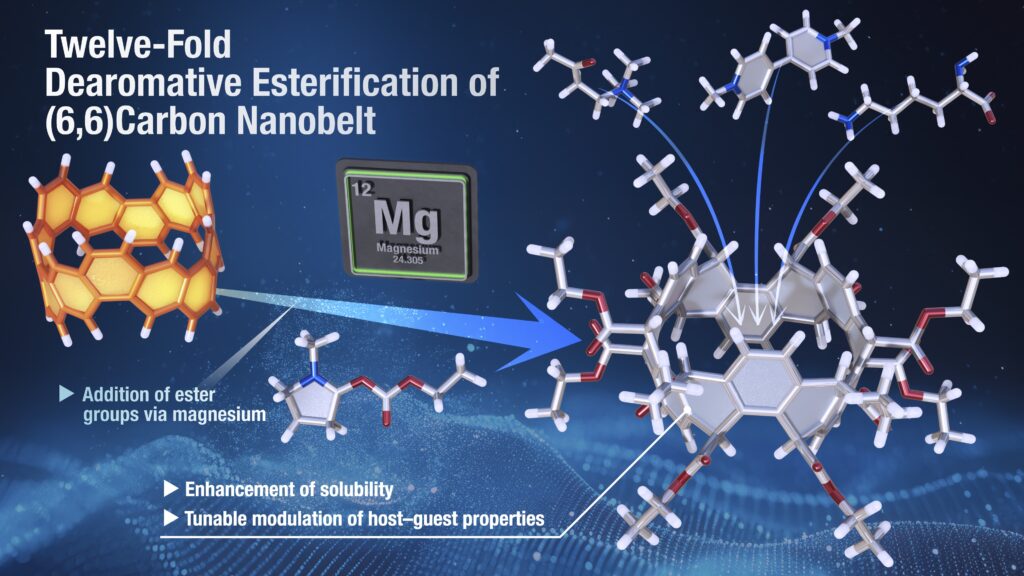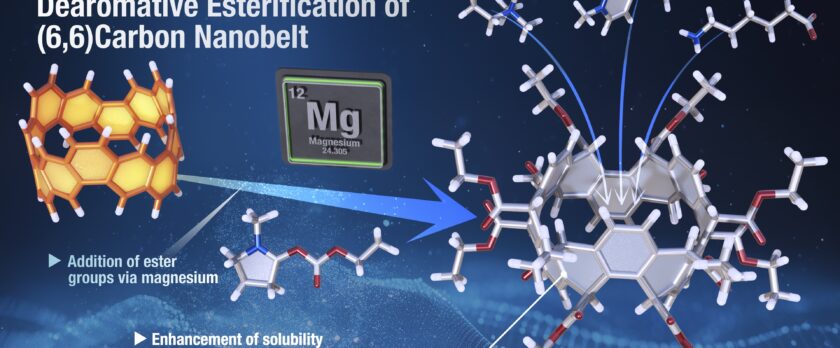Our research on the one-step multi-functionalization of carbon nanobelts has been published in Angewandte Chemie International Edition!
Twelvefold dearomative esterification of (6,6)carbon nanobelt
Tsubasa Okumura, Daiki Imoto, Yuri Arachi, Akiko Yagi, Takehisa Maekawa, Kenichiro Itami
Angew. Chem. Int. Ed. 2025, Early View.
Carbon nanobelts (CNBs), macrocyclic molecules composed of carbon atoms arranged in a cylindrical fashion, have fascinated scientists for nearly 70 years due to their intriguing chemical structure and physical properties. Since our laboratory first reported the synthesis of the (6,6)carbon nanobelt ((6,6)CNB) in 2017, various types of CNBs have been synthesized worldwide. Today, their applications are expanding beyond materials science fields such as organic electronics and supramolecular chemistry, and into the realm of life sciences.
To accelerate the applied research of CNBs, it is essential to develop methods that allow fine control over their structure and properties through direct functionalization. However, direct functionalization of CNBs has been difficult to control, and only a few successful examples have been reported to date.
Focusing on the periodic structure of (6,6)CNB, which contains reactive anthracene units, we explored the use of this reactivity to achieve direct functionalization. This led to the discovery of a regioselective esterification reaction mediated by metallic magnesium. The reaction installs twelve ester groups onto the CNB in a single step, resulting in a highly functionalized CNB with dramatically improved solubility.
We also investigated the host–guest properties of this multi-functionalized CNB, which has a tubular macrocyclic structure. Unlike unmodified (6,6)CNB, which does not encapsulate positively charged organic molecules such as methyl viologen, the functionalized CNB was found to bind such guests, albeit weakly. Moreover, biologically relevant cationic molecules such as lysine and acetylcholine were also observed to be taken up into the inner cavity. Theoretical analysis revealed that the emergence of host–guest behavior stems from the structural change of (6,6)CNB from a rigid to a relatively flexible form induced by multi-functionalization.
In this study, we developed a novel method enabling direct and multi-functional modification of carbon nanobelts, a challenge that had previously been difficult to achieve. By overcoming long-standing limitations—such as poor solubility and limited tunability for specific applications—our approach paves the way for a broader use of CNBs. Specifically, enhanced solubility through multi-functionalization may facilitate the creation of new biomaterials by integrating CNBs with biomacromolecules like proteins and sugars. Furthermore, the ability to tune host–guest properties opens up new avenues for applications in molecular sensing and supramolecular materials.

Image created by Dr. Issey Takahashi (Nagoya University, ITbM)


 日本語
日本語





















